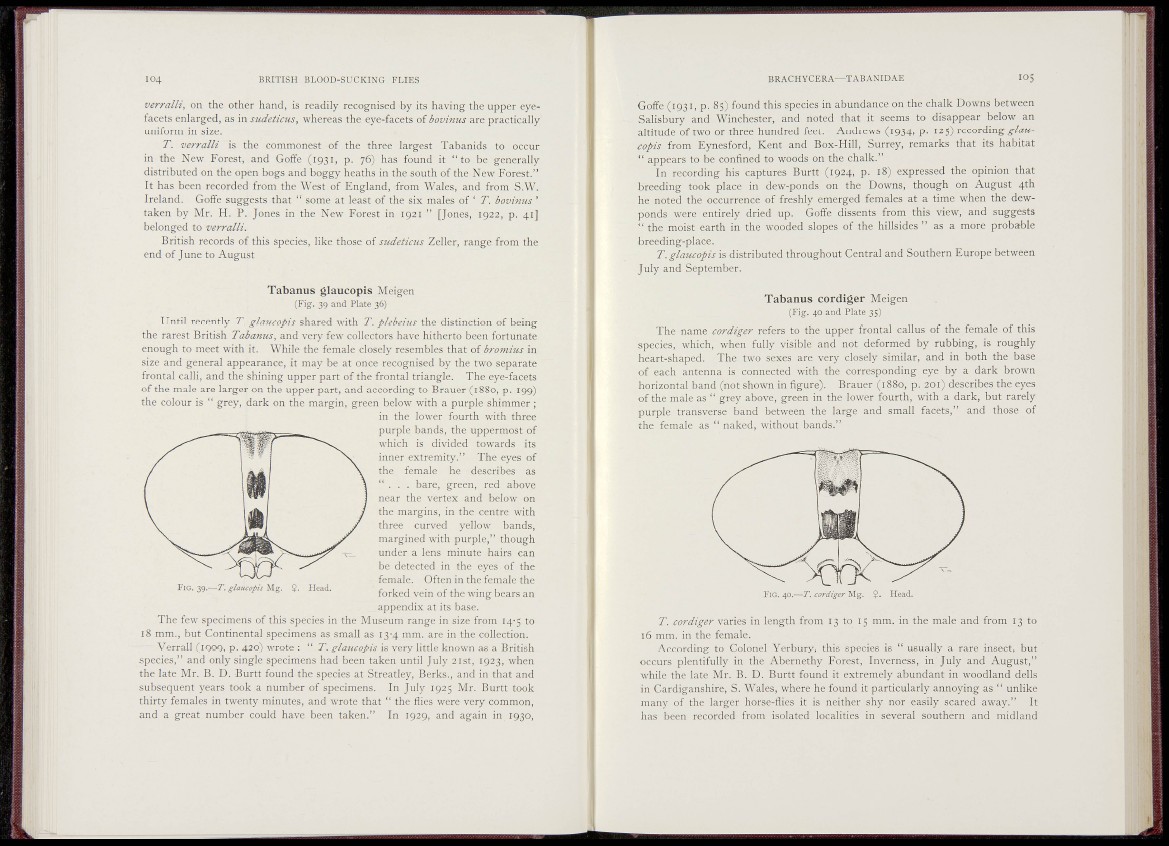
104 BRITISH BLOOD-SUCKING FLIES
verralli, on the other hand, is readily recognised by its having the upper eyefacets
enlarged, as in sudeticus, whereas the eye-facets of bovi?ius are practically
uniform in size.
T. verralli is the commonest of the three largest Tabanids to occur
in the New Forest, and Goffe (1931, p. 76) has found it "to be generally
distributed on the open bogs and boggy heaths in the south of the New Forest."
It has been recorded from the West of England, from Wales, and from S.W.
Ireland. Goife suggests that " some at least of the six males of ' T. bovimis '
taken by Mr. H. P. Jones in the New Forest in 1921 " [Jones, 1922, p. 41]
belonged to verralli.
British records of this species, like those of sudeticus Zeller, range from the
end of June to August
Tabanus glaucopis Meigen
(Fig. 39 and Plate 36)
Until recently T. glaucopis shared with T. plebeiiis the distinction of being
the rarest British Tabamis, and very few collectors have hitherto been fortunate
enough to meet with it. W'hile the female closely resembles that of bromius in
size and general appearance, it may be at once recognised by the two separate
frontal calli, and the shining upper part of the frontal triangle. The eye-facets
of the male are larger on the upper part, and according to Brauer (1880, p. 199)
the colour is " grey, dark on the margin, green below with a purple shimmer ;
in the lower fourth with three
purple bands, the uppermost of
which is divided towards its
inner extremity." The eyes of
the female he describes as
" . . . bare, green, red above
near the vertex and below on
the margins, in the centre with
three curved yellow bands,
margined with purple," though
under a lens minute hairs can
be detected in the eyes of the
female. Often in the female the
forked vein of the wing bears an
appendix at its base.
FIG. 39.—T. glaucopis Mg. Head.
The few specimens of this species in the Museum range in size from 14-5 to
18 mm., but Continental specimens as small as 13-4 mm. are in the collection.
Verrall (1909, p. 4 2 0 ) wrote : " 3". glaucopis is very little known as a British
species," and only single specimens had been taken until July 21st, 1923, when
the late Mr. B. D. Burtt found the species at Streatley, Berks., and in that and
subsequent years took a number of specimens. In July 1925 Mr. Burtt took
thirty females in twenty minutes, and wrote that " the flies were very common,
and a great number could have been taken," In 1929, and again in 1930,
BRACHYCERA—TABANIDAE 105
Goffe (1931, p. 85) found this species in abundance on the chalk Downs between
Salisbury and Winchester, and noted that it seems to disappear below an
altitude of two or three hundred feet. Andrews (1934, p. 125) recording glaucopis
from Eynesford, Kent and Box-Hill, Surrey, remarks that its habitat
" appears to be confined to woods on the chalk."
In recording his captures Burtt (1924, p. 18) expressed the opinion that
breeding took place in dew-ponds on the Downs, though on August 4th
he noted the occurrence of freshly emerged females at a time when the dewponds
were entirely dried up. Goffe dissents from this view, and suggests
" the moist earth in the wooded slopes of the hillsides " as a more probable
breeding-place.
T. glaucopis is distributed throughout Central and Southern Europe between
July and September.
Tabanus cordiger Meigen
(Fig. 40 and Plate 35)
The name cordiger refers to the upper frontal callus of the female of this
species, which, when fully visible and not deformed by rubbing, is roughly
heart-shaped. The two sexes are very closely similar, and in both the base
of each antenna is connected with the corresponding eye by a dark brown
horizontal band (not shown in figure). Brauer (1880, p. 201) describes the eyes
•of the male as " grey above, green in the lower fourth, with a dark, but rarely
purple transverse band between the large and small facets," and those of
the female as " naked, without bands."
FIG. 40.—T. cordiger Mg. Head.
T. cordiger varies in length from 13 to 15 mm. in the male and from 13 to
16 mm. in the female.
According to Colonel Yerbury, this species is " usually a rare insect, but
occurs plentifully in the Abernethy Forest, Inverness, in July and August,"
while the late Mr. B. D. Burtt found it extremely abundant in woodland dells
in Cardiganshire, S. Wales, where he found it particularly annoying as " unlike
many of the larger horse-flies it is neither shy nor easily scared away." It
has been recorded from isolated localities in several southern and midland